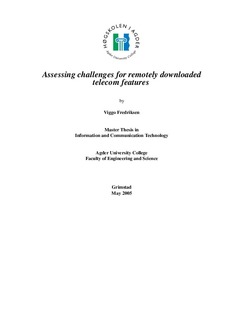| dc.contributor.author | Fredriksen, Viggo | |
| dc.date.accessioned | 2007-06-28T08:20:13Z | |
| dc.date.issued | 2005 | |
| dc.identifier.uri | http://hdl.handle.net/11250/137198 | |
| dc.description | Masteroppgave i informasjons- og kommunikasjonsteknologi 2005 - Høgskolen i Agder, Grimstad | en |
| dc.description.abstract | The telecom and software industries are converging, providing new market and revenue potentials
for both industries. Personalization of services and applications is an emerging trend, and
this thesis suggests using remotely downloaded UML 2.0 submachines components as a candidate
for enabling this. This thesis thus assess the challenges raised by replacing submachines at
run-time.
This report gives an introduction to the core technologies of interest in this thesis work; UML 2.0
and Ericsson’s service creation architectures. Ericsson’s service creation architecture is a set of
frameworks for development of services and applications with the new hybrid networks created
by the merging of the Internet and the telecom service networks. This architecture is built upon
the UML 2.0 concepts of asynchronous communication through message passing and the use of
Actors.
There are several issues which must be evaluated when allowing remotely downloaded and replaceable
submachines at run-time. This thesis does not try to solve all these issues, but tries to
alleviate potential problems by decomposing the externally visible properties of the structured
classifier in which the state machine is deployed. This allows us to assert these properties at
run-time, and the thesis hence introduces a concept called the event acceptor. This approach is
based on the UML 2.0 concepts of the port and the protocol state machine. Solutions for setting
up connectors between ports, sending and replying to messages and execution of the assertion
mechanism are shown.
The main conclusion of this thesis is that run-time replacement of submachines is both useful
and viable. Allowing such replacement to happen enables personalization of running services
and applications. At the same time services may increase their longevity by adding new and
emerging technologies without affecting their availability. Although this has not been a formal
study, it has been shown to work when there exists mechanisms which can detect erroneous behavior
– such as the run-time event acceptor proposed by this thesis.
The main contribution of this thesis is the run-time event acceptor. Ideas on how to route,
send and reply to messages is proposed and implemented. Furthermore, a solution on how to
configure connectors using signaling is proposed and implemented. The implementation of an
example phone book service suggests that this solution work well, and that the introduced concepts
should be comprehendable by designers and developers familiar with the NorARC service
creation architectures. | en |
| dc.format.extent | 982564 bytes | |
| dc.format.mimetype | application/pdf | |
| dc.language.iso | eng | en |
| dc.publisher | Høgskolen i Agder | |
| dc.publisher | Agder University College | |
| dc.subject.classification | IKT590 | |
| dc.title | Assessing challenges for remotely downloaded telecom features | en |
| dc.type | Master thesis | en |
| dc.subject.nsi | VDP::Matematikk og naturvitenskap: 400::Informasjons- og kommunikasjonsvitenskap: 420::Kommunikasjon og distribuerte systemer: 423 | |
| dc.subject.nsi | VDP::Matematikk og naturvitenskap: 400::Informasjons- og kommunikasjonsvitenskap: 420::Systemutvikling og -arbeid: 426 | |
